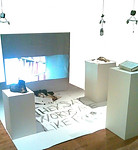Problems with History (2008)
Paintings and multi-media installations

"...those footprints backwards in the snow whispering 'i know you were here,' 'I read your secrets in the cold...'"
-kurtis lesick, Problems with History.

They say that words are like footsteps
falling one after the other
tracing paths across white paper
anecdotes frozen to the page
become memories for all who have read
those clear words that mask intensions
those footprints backwards in the snow
whispering “i know you were here”
“I read your secrets in the cold”
those footprints, we thought they revealed
our paths irrefutable
but footprints, like ice and words, fade
they say that words like foot steps
we wonder who said this wisdom
but their names were never written
Problems with History considered the ways in which our relationships with media and materiality manifest themselves in the production of human history. Our readings and misreadings, our cultural baggage and subjectivities, our political motivations, our fears and insecurities all re-materialise themselves into histories that write over the original event. History from this perspective is a complex simulacrum which, at the same time that it connects us to our past, parasitically devours that past and replaces it with itself.
Problems with History | Element 14
Problems with History – Element 14 is a multi-media installation that explores the liminal space between history, reality, and the fragmented traces of the past. The installation is built upon a large mat of paper. Three plinths inhabit the front half of the paper, each accessorised with artefacts. On the first are two history books; on the second a burnt journal; on the third a boot with a stoke of yellow paint. Above each plinth hangs a set of stripped down speakers attached to an ipod.
One set of speakers plays archival news footage from world war II;
another plays audio of people discussing memories of their family;
the final set play a poem that interprets the installation.
The sound from these speakers bleeds together into a cacophonous din until you station yourself at one of the plinths where the speakers become differentiated.
Between the plinths, written in charcoal on the paper mat, are the words “They say words are like footsteps”. Above the words, in the middle of the paper sits a hearth of burnt books and charred wood. Suspended above the hearth is a parchment screen which holds a video projection (music by Sam Shalabi: Shalabi Effect).
As the piece ages in its installation context the audience slowly rewrites the experience through the imposition of their footprints on the paper mat. The charcoal writing is displaced by the dirty, wet footmarks of winter, a spilt glass of wine, a drop of coffee. The text is displaced and obscured by their presence. Their presence is displaced by the presence of others. Behind the screen lies the only truth–a reward for those who transgress the polite boundaries of installation art–less impacted by the footsteps of an empowered public. Here the words to the poem of the piece lie strewn in vulnerable, but everlasting charcoal protected by the distraction of the screen.

Problems with History | Element 15
Element 15 (Ghosts of Industry | Memory) is the third in a series of installations/web properties themed on the industrial ghost town of Bitumount. The installation explores the relationship between the past, its documentation, and its virtualised representation.
The room is equipped with a large, stark white table on which sits a white keyboard and mouse. This is used to navigate through the Ghosts of Industry website which is projected on a wall of archival letters, legal documents, technical reports and photos. The other walls in the room are papered in such documents. A fan moves the papers on the projection wall animating the projection.
Element 15 makes for a visceral contrast between the what we’ve come to understand as the perfect digital copy and the tangible, concrete, and authentic physical traces of the past. In fact, it is up to the physical properties of the real paper documents to bring the virtual projection to life. The audience is invited to explore both the stories on the wall (the archival documents used to research the web documentary) and the simulacra projected upon them. For many, it is the draw of the paper, those dirty cumbersome objects, that proves irresistible next to the flash of the virtual world. They move sheet by sheet reading through the authentic physical archives leaving the virtual world blowing in the wind.
























